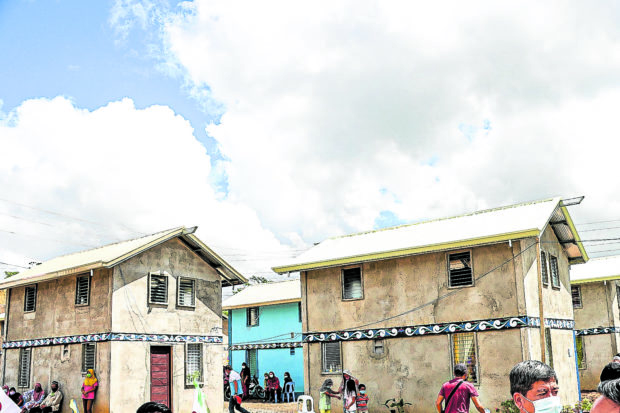
The ongoing massive rehabilitation of Marawi will propel the country’s only Islamic City to rise again, modern and prosperous.
To say that it is overwhelming to be an instrument for the realization of other people’s dreams is an understatement. I had that great feeling last Thursday, Feb. 25, when we awarded permanent shelters to 109 families of internally displaced persons (IDPs) in Marawi City.
Today, these families have houses they can call their own—a dream being pursued by no less than our President Duterte for every Filipino family. A momentous day indeed.
Permanent shelters
It was the first time that the government, through Task Force Bangon Marawi and its partner agencies, turned over permanent shelters to Marawi IDPs since the massive rehabilitation in this city started. To recall, Daesh-inspired terrorists attempted to seize Marawi City, which led to a five month battle that started in May 2017 and ended in October.
Seeing the beneficiaries, who donned their colorful traditional clothing, flashing their biggest smiles was fulfilling. Indeed, these permanent shelters are key to helping our Maranao brothers and sisters get back on their feet, full of hope and optimism for the future of the only Islamic City in the country.
I share this feeling with Japan Ambassador Koshikawa Kazuhiko; Christopher Rollo, UN-Habitat country program manager, Social Housing Finance Corp. (SHFC) president Arnolfo Ricardo Cabling and Marawi City Mayor Majul Gandamra—each of them playing a key role in the development and construction of permanent shelters in Barangay West Dulay, Marawi City.
Collaboration
The Japan government provided $10 million fund for the project while SHFC took charge of the land acquisition and site development. The UN-Habitat, using the Japan grant, constructed the housing units through community participation. This formed part of the more than 3,000 permanent shelters programmed to accommodate all IDPs, particularly those living along danger zones in Marawi City.
The 109 permanent shelters are located in Hadiya Village, named aptly so since “hadiya” means “gift” and these housing units are a precious gift from President Duterte, the Japanese government and UN-Habitat to the IDPs who almost lost their hope after the 2017 siege.
The two-story core house meanwhile has a floor area of 42 sqm and is built on a 100-sqm lot. Each unit has a toilet and bathroom, a kitchen, basic electrical lighting, water lines and a sewage piping system. The beneficiaries can make improvements to the core house such as room partitions—definitely better than the previous abodes of the IDPs along the dangerous banks of Agus River and Lake Lanao.
Apart from these housing units, we intend to construct common areas like mosques and rainwater collection tanks to augment the current water supply system and to complete the subdivision-like development of 1.8-hectare Hadiya Village.
Amanoding Pumbaya Dirampatun received last week his Certificate of Conditional Award from Task Force Bangon Marawi chairman Eduardo del Rosario and Marawi City Mayor Majul Gandamra. Dirampatun is one of the 109 IDP families who were awarded permanent housing unit inside Hadiya Village
I am particularly proud that we managed to deliver this initial batch of permanent shelters barely months after the Marawi infrastructure rehabilitation works went on full blast last July 2020—amid the imposition of enhanced community quarantine brought about by the COVID-19 pandemic.
Continuing efforts
Meanwhile, other permanent shelters being constructed by the National Housing Authority (NHA) are now in various stages of completion and would be ready for distribution by the December deadline as stated in our master development plan. Likewise, the Bangsamoro Autonomous Region in Muslim Mindanao also committed to construct houses for Marawi IDPs.
We intend to award more permanent shelters every month to enable our displaced Maranao brothers and sisters to start a fresh life in their new homes—a commitment we made when we accepted the challenge of leading the rehabilitation of Marawi City.
Parallel to our efforts of building new homes for the IDPs is the revalidation of the master list of housing beneficiaries to ensure that only the deserving ones get shelter grant from the government. The TFBM has been working closely with the local government of Marawi City and civil society groups to come out with a clean list.
Overall, the TFBM, along with its 56 implementing agencies, has so far completed 40 percent of the infrastructure rehabilitation works. Construction of major infrastructure projects within the most affected area or “ground zero” like road networks with underground power, water and telecommunication facilities; mosques; the mall-like Grand Padian Market; school buildings, museum, the massive School of Living Tradition, peace memorial and barangay complexes with health centers and madrasahs have been in full swing.
On behalf of TFBM, let me extend my deepest gratitude to all our partners, especially to the Marawi LGU led by Mayor Gandamra, the Marawi traditional leaders, international development partners, civil society organizations and the peace-loving Maranaos. Together, we will not only rebuild our only Islamic City, we will propel Marawi to rise as a modern and prosperous city again.

